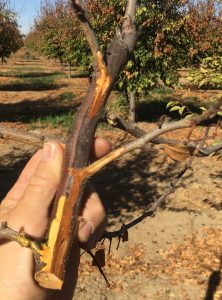Luke Milliron, UCCE Orchards Advisor, Butte, Glenn, and Tehama Counties
Franz Niederholzer, UCCE Farm Advisor; Colusa and Sutter/Yuba Counties
Allan Fulton, UCCE Irrigation and Water Resources Farm Advisor Emeritus
Richard Buchner, UCCE Farm Advisor Emeritus
Pre-Harvest Irrigation – The “Why” and the “How”:
Why does it matter how water stressed trees are during summer and just before harvest? Keeping prune tree water stress mild to moderate from late June through to early August has a couple key benefits. Mild to moderate water stress slows shoot growth, saving pruning expenses without affecting fruit sizing (fresh and dry weights). In addition, sustaining this mild to moderate stress helps manage energy and irrigation costs.
An irrigation cut off one to two weeks ahead of harvest in late-August also delivers benefits. The moderate to high levels of crop stress experienced by the trees with this irrigation cut off may increase sugar content in fruit and reduce moisture content or “dry-away” (fruit drying costs). The cut off also reduces the risk of bark damage at harvest.
How do we achieve mild to moderate water stress during summer and the moderate to high levels of stress just before harvest? It may be unwise to rely on previous experience alone this year to achieve these different levels of water stress, since low rainfall likely led to less soil water content all season-long. In addition to experience, other approaches include ET calculations and soil moisture monitoring. ET calculations and soil moisture can be used to manage tree water stress; however, they do not directly measure the water stress of the tree. Pressure chamber stem water potential (SWP) readings do directly measure tree water stress and can be used to help deliver these beneficial stress timings, while avoiding the unwanted consequences of severe stress. Mild to moderate stress (SWP readings of -12 to -16 bars) from late June up to the preharvest irrigation cut-off and again after harvest, achieve the desired mild to moderate stress level without harm to the orchard (Table 1). Cutting off irrigation in the week or two before harvest to achieve -16 to -20 bars SWP delivers the desired moderate to high stress that helps reduce dry away and trunk damage (“barking”) at harvest.
Growers with orchards (or replants) on the new Krymsk 86 (K86) rootstock should take special care to make sure trees are sufficiently dried down before shaking to avoid bark damage. Don’t expect K86 rooted trees to dry down as quickly as those on Myrobalan or Marianna-type rootstocks (M29C, M40, and M2624). Regular SWP monitoring between your irrigation sets can help you get a sense of how long it will take to dry down your trees on K86 to the -16 to -20 range before harvest.
Table 1. SWP levels in prune, consideration of how SWP might compare to baseline values under various weather conditions, and the corresponding water stress symptoms to expect.
| SWP range (bars) | General Stress Level | Water stress symptoms in prune |
| -8 to -12 | Low to mild | Favors rapid shoot growth and fruit sizing in orchards when minimal crop stress is sustained from April through mid-June. Continuing to maintain low-mild stress into the summer may not be cost effective. |
| -12 to -16 | Mild to Moderate | Suggested mild levels of stress during late June, July, and early August. Shoot growth slowed but fruit sizing (fresh and dry weights) is unaffected. May help manage energy and irrigation costs. |
| -16 to -20 | Moderate to High | Should be avoided until fruit sizing is completed. Appropriate for late August (preharvest shut down). Imposing moderate to high levels of crop stress by reducing irrigation about two weeks before harvest may increase sugar content in fruit and reduce moisture content or “dry-away” (fruit drying costs). |
| -20 to -30 | High to Severe | More likely to occur in late August and early September during and after harvest. Extended periods of high crop stress before harvest will result in defoliation and exposure of limbs and fruit to sunburn. Extended periods of high stress after harvest may also negatively affect the condition of trees going into dormancy. |
Post-Harvest Irrigation – The “Why” and the “How”:
Once the crop is out of the field, follow through with careful irrigation management until either the trees have lost their leaves or there is regular autumn rain. Post-harvest irrigation should recover the trees to mild- to moderate-stress (-12 to -16 bars SWP) in-order to not reduce photosynthesis and disrupt carbohydrate allocation to storage leading into overwintering. Care must be taken with any irrigation reductions – severe water stress can potentially damage the orchard for years to come. Sustained high to severe water stress during the pre- and post-harvest period can reduce potassium uptake, encourage sunburn and growth of Cytospora cankers (Figure 1) and result in smaller fruit buds the following year. Don’t walk away from your prune irrigation after harvest. You might not like what your orchard looks like at bloom.

Figure 1. Cytospora canker infections spread most rapidly in severely water stressed (lower than -30 bars SWP) orchards. High to severe water stress is more likely to occur in late August and early September during and after harvest. Photo by Franz Niederholzer.


Leave a Reply